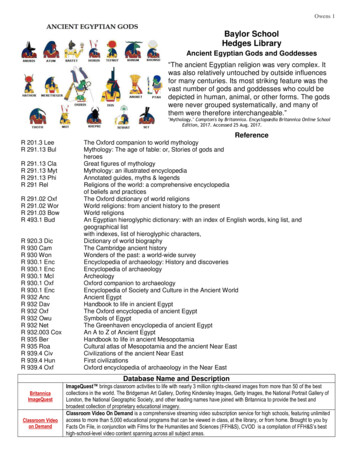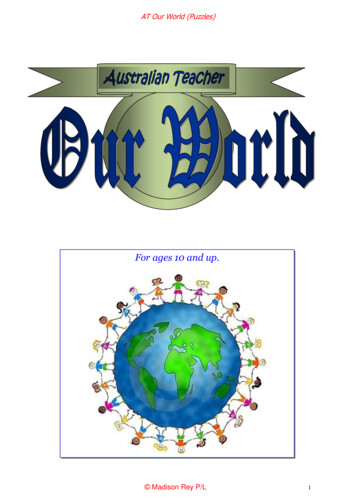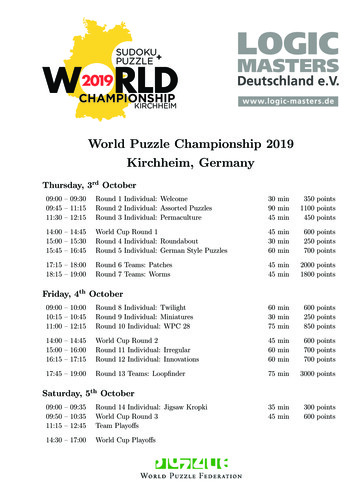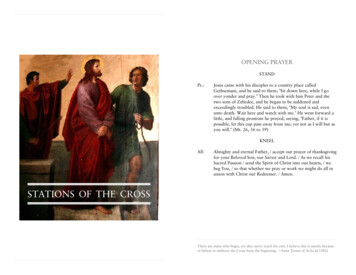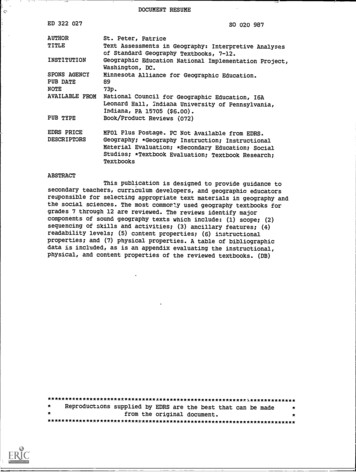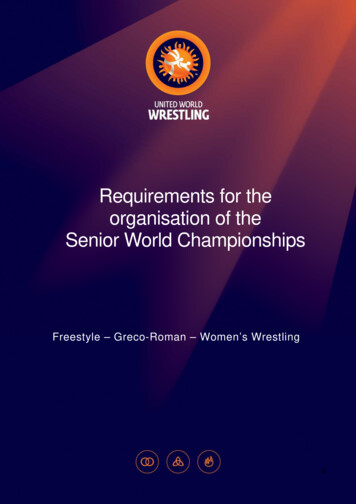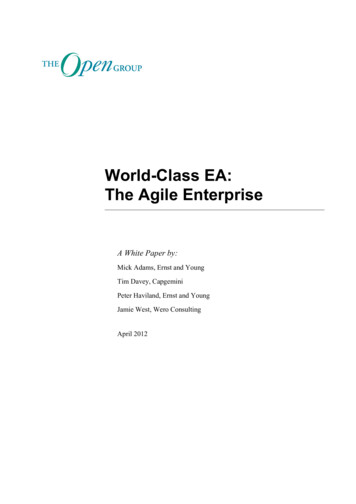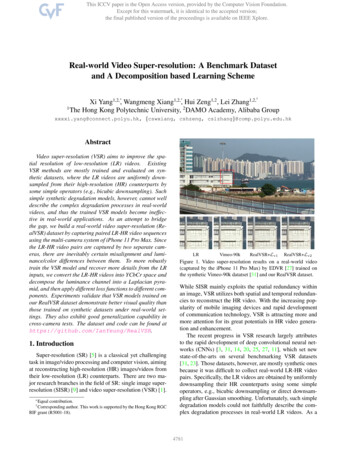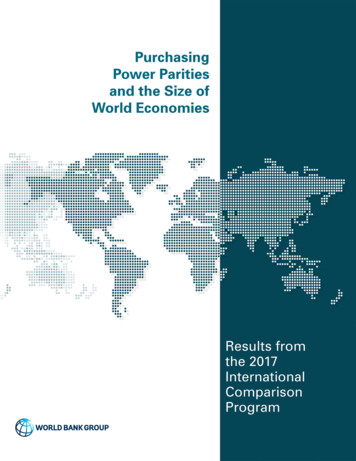
Transcription
Not of This World:A Treasury of Christian MysticismNot of this World: A Treasury of Christian Mysticism, edited byProf. James Cutsinger, challenges the notion that Christianity is apurely devotional path. It is widely supposed–by seekers whosecontemplative journeys have taken them to the East–that the “love ofGod” is alone the primary obligation and the highest goal in aChristian’s spiritual life, which thus leaves no scope forcontemplation as an integral part of this spiritual life. Not of thisWorld invites the reader to explore a deeper and often overlookeddimension of Christian mysticism in which the accent is placed on theacquisition of gnosis (knowledge) and in which theosis (deification)is presented as the goal of the spiritual journey.Not of this World is a collection of short meditations on thecontemplative life, drawn from a wide variety of Christian sourcesthat range from the second to the twentieth centuries. Guided bywriters whose backgrounds and experiences cross all sectarian divisions, the reader is invited totake part in a journey that follows the three classic stages of Purification, Illumination, and Union.Unlike any previously published work, in drawing from nearly two thousand years of Catholic,Eastern Orthodox, and Protestant sources, Not of this World is the first primary sourceanthology of Christian mysticism that focuses on the acquisition of spiritual knowledge and“deification” as explicit goals of the Christian spiritual path. It is also in the unique position ofbeing a work that will be at home on someone’s bedside table providing inspiration to ordinarybelievers, as it will be within the classroom as a valuable teaching tool.An Excerpt from the Foreword“God’s Kingdom is certainly not of this world – the fallen world of corruption, competition, anddeath. But beneath the surface of this, the Gospel teaches that there is also a that: a world ‘soloved’ (John 3:16) by God that He has entered it fully in order to make it one with Himself Beginning in the early years of the Church, the journey of those who were in search of that world,and who were prepared to dedicate themselves fully to the most fruitful of quests, was dividedinto three major stages: Purification, Illumination, and Union. The reader is invited to be a partof this journey. Taking the lead and giving their encouragement will be some of the wisest andmost eloquent writers in the history of Christian spirituality, ranging from the second to thetwentieth centuries and representing the Catholic, Eastern Orthodox and Protestantperspectives.”- James S. Cutsinger, from the ForewordWorld Wisdom
Which readers will be interested in this work?Not of This World will appeal to a variety of readers: Practicing Christians will find this single volume of writing contains some of the mostinspiring voices in the history of Christian spirituality. It will provide practical instruction onhow to enter more deeply into contemplative prayer as well as encouragement for thosestriving to come closer to God. Spiritual seekers, whose journeys in the past have taken them to the East for nourishment,will find that this profoundly beautiful book focuses on the often neglected dimensions ofChristian gnosis (spiritual knowledge) and theosis (deification), demonstrating thatChristianity has an ancient but still-living tradition of contemplative practice. As an ideal introduction to the vast subject of Christian spirituality and mysticism, Collegeand Seminary students will find Not of this World of great use in courses on the history ofChristianity and Comparative Mysticism because of its use of sources from nearly twothousand years of the Catholic, Eastern Orthodox and Protestant traditions. Through itsdozens of short excerpts from authors of different denominations and historical periods, thisbook offers much to readers able to perceive a mystical unity underlying all such differences. Students of Comparative Religion and Mysticism will find enlightening parallels betweenthese writings and the teachings of such diverse traditions as Sufism, Taoism, ZenBuddhism, and Hinduism, particularly Vedanta.Additional publication informationNot of This World also contains a detailed index and a selection of recommendations for furtherstudy on various topics addressed by the book.Not of This World has an expected publication date of Spring 2003 and a price of 19.95.Visit the “Press Room” at www.worldwisdom.com for more information.
What is being said about Not of this World“Increasingly as a composer, I want to 'hear' God, and tend to be wary of yet another book onmysticism in any Tradition. However, James Cutsinger in Not of This World allows the masters ofthe Christian Tradition to speak on their own terms, thus permitting us to 'hear' God through theirunique perspective.”—Sir John Tavener, composer and author“Cutsinger has assembled a dazzling chorus of voices to explore the mysteries of Christian gnosisand deification. His selection is daring (where else can one find Boehme, Dante, and C.S. Lewisside-by-side?) and his taste superb. I can’t think of a better collection to place in the hands ofanyone seeking to explore the Christian mystical tradition.”— Philip Zaleski, editor of The Best Spiritual Writing series“At a time when the Christian tradition is under siege by the profane ideologies of modernity, andwhen Christian institutions themselves are torn by doubt and division, this anthology serves asan urgent reminder of that quintessential wisdom which cannot be compromised by thevicissitudes of time. From the days when the Master Himself walked the shores of Galilee downto our own time the Christian mystics have been living exemplars of a transformative andsapiential spirituality wherein both love and knowledge perform their mysterious alchemy on thesoul. Professor Cutsinger is to be warmly commended for his judicious selection of mysticalwritings and for an arrangement which enhances their perennial themes. Here, in a singlevolume, may be found many Christian refractions of that ever-present Light which irradiates allintegral traditions.”—Kenneth Oldmeadow, La Trobe University, Bendigo, and author of Traditionalism: Religion inthe Light of the Perennial Philosophy“Not of This World is indeed a spiritual treasury garnered from near and far reaches of theChristian tradition, ancient, medieval, and modern, Eastern and Western, Orthodox, Catholic,and Protestant, with the special merit of integrating contemplative asceticism or mysticism andwhat might be called a metaphysical perspective into a living whole. The introduction to thissplendid collection is in itself a little jewel. If there is a guiding principle in the selection it is theperennialist or traditionalist . . . orientation of the editor.”—Ralph Slotten, Professor Emeritus, Dickinson CollegeWorld Wisdom
“Beautifully crafted and skillfully structured, this vade mecum of spiritual insights and counselswill be treasured by all Christian readers who are drawn toward the inner dimension of theirtradition.”—Patrick Laude, Georgetown University, and author of The Way of Poetry“There are many anthologies of Christian mysticism, but few that range so widely as this: fromthe first century to the twentieth, and embracing equally Western Christianity—both Catholic andProtestant—and the Christian East, even the Far East. The book is arranged in three broadsections taking the reader from purification, through illumination, to union with God. Each ofthese sections is further subdivided to explore the different experiences of the way to union withGod, from severe austerity, through diaphanous understanding, to an experience of union thattranscends unity.”—Andrew Louth, University of Durham, and author of Origins of the Christian MysticalTradition: From Plato to Denys“In this anthology, Dr. James Cutsinger has prepared a mystical feast of a very high order. Anastutely chosen, brilliantly edited bouquet of spiritual writings, Not of This World will likelyproduce an extraordinary effect on the attentive reader, for this is an anthology unlike any otherin my experience. More than a mere collection of "wise sayings" and mystical writings gatheredin one place for the reader's convenience, this book is rather a catalogue to the curriculum of ahigher School, a wardrobe to the land of true and everlasting knowledge, a hint of God's ownbreath in the inner ear. It does not ask to be read like an ordinary book, it calls the reader himselfto be reader, text, book and truth in the experience of the ‘joyful instant’ of Christian gnosis. Thelast sentence of the book's final selection says it all and says it best: ‘Reader, it is enough. But ifthou still wouldst read, then be thyself the book, in thought, word, life and deed.’"—Vincent Rossi, Director of Education for the American Exarchate of the Jerusalem Patriarchateof the Orthodox ChurchVisit the “Press Room” at www.worldwisdom.com for more information.
Editor ofNot of this World: A Treasury of Christian MysticismJames S. CutsingerJames S. Cutsinger is Professor of Theology and Religious Thought at the University of SouthCarolina and is an important contemporary author on spirituality, particularly within the Christiantradition. He is also emerging as one of the most widely recognizedauthorities on the Perennialist (Traditionalist) school of comparativereligious thought. Professor Cutsinger currently serves as secretary to theFoundation for Traditional Studies and is the recipient of numerousteaching awards (he was honored in 1999 as a Michael J. Mungo UniversityTeacher of the Year). He offers courses at both the undergraduate andgraduate levels in Religious Studies at USC.Professor Cutsinger is now working with World Wisdom on the long-termproject of editing revised editions and anthologies of the works of FrithjofSchuon, the late philosopher, poet, and artist of whom Professor Cutsingeris one of the world’s best known commentators.Professor Cutsinger is a nationally known advocate of Socratic Teaching based on the classics.His consulting work has included curriculum development and design, contributions to greatbooks seminars for professionals, and workshops in discussion-based pedagogy. He has alsoserved as director of three National Endowment for the Humanities Summer Seminars.Previous books by James S. CutsingerPaths to the Heart: Sufism and the Christian EastPaths to the Heart (World Wisdom, 2002) examines the common elements ofSufism, the mystical tradition of Islam, and Orthodox Christianity. The essayspresented in this work were originally given at the Paths to the HeartConference, and represent the words of some of the greatest contemporaryexperts in their respective fields.“The peace of the world in the new century may depend in no small measure onthe ability of the Islamic world and historically Christian countries to communicate with oneanother. Perhaps the best hope for deeper understanding between Christians and Muslims lies inthe fact that the finest thinkers in both religions have drawn on a common pool of imagery—thelanguage of the heart—as they try to describe what is ultimately beyond words: the humanencounter with God.”—Bruce Clark, The EconomistWorld Wisdom
Advice to the Serious Seeker: Meditations on the Teaching of Frithjof SchuonAdvice to the Serious Seeker is an introduction for scholars to the Perennialistschool of comparative religious philosophy. At the same time it is a valuableguidebook for the general reader who is looking for intellectually serious butaccessible answers to questions about the spiritual world.“Advice to the Serious Seeker introduces the main tenants of Perennalist Schoolof comparative religious philosophy through the teachings of its maincontemporary expositor (Frithjof Schuon).”- Book News Inc.Reclaiming the Great Tradition: Evangelicals, Catholics, and Orthodox in DialogueReclaiming the Great Traditions is a collection of essays that seeks to overcomethe sectarian differences of the Christian traditions by focusing on suchelemental truths as the Trinity and the divinity of Christ.“Reclaiming the Great Tradition is an illustration of the need for a properunderstanding of the content of the common faith and of the way to arrive at thepractical oneness of this faith.The core of the faith – that is the concern of this important volume.”- Affirmation and Critique – A Journal of Christian ThoughtThe Form of Transformed Vision: Coleridge and the Knowledge of GodthThe Form of Transformed Vision examines the work of the 19 Century poet,Samuel Taylor Coleridge, with special regard to his work on God and the natureof the Divine.“It is by some such standard that Professor Cutsinger would have us measure anydisproportion we may feel between the meticulous, unhurried, superabundantlydocumented exegesis of Coleridge’s thought which constitutes the bulk of hisbook, and the propounding of its primary theological purpose. Enlightenment, that is to say thetransformation of theory into vision, if and when it comes, will speak for itself.”- Oren Barfield – from the ForewordVisit the “Press Room” at www.worldwisdom.com for more information.
Contributors of essays in Not of This WorldSome of the notable contributors to the over thirty essays contained in Not of This World are:St. Ignatius of Antioch was, according to legend, the child that Christ took up in His arms, asdescribed in Mark 9:35. He was appointed as Bishop of Antioch by the hand of St Peter himself.Under the persecution of the Emperor Trajan, he was martyred in the Flavian amphitheatersometime between 98-117 Ad.St. Augustine of Hippo was one of the most prolific geniuses that the Church has ever known.He is admired for not only the volume of his work, but also the wide variety of subjects that headdressed. His chief work was City of God, begun in 413, which frames theology within thehistory of mankind and attempts to explain the actions of God in the world.St. Maximos the Confessor, born in Constantinople in 580, was a high-ranking courtier in theByzantine Court who became a monk late in life. He was the greatest defender of Orthodoxyagainst the Monothelite heresy. In defending his faith against both the Emperor of Byzantiumand the Patriarch of Constantinople he was exiled and suffered having both his tongue cut outand his hand chopped off.St. Anselm, Archbishop of Canterbury and Doctor of the church, was born in France in 1033. Hischief works Monologium and Proslogium are often overshadowed by works of other greatthinkers of the Church. However, his greatest philosophical achievement was his ontologicalargument for the existence of God. This argument has greatly influenced the writing of manyphilosophers and theologians throughout the ages.St. Bernard of Clairvaux was the founder of the Cistercian monastic order. Born of Frenchnobility he entered the monastery at Citeaux at the age of 22. Within three years of his entry, hehad founded a new abbey at Clairvaux. Even though he was regarded as one of the mostinfluential men of his day, defeating the anti-pope in the great schism of 1130 and preaching themessage of the Second Crusade, he remained throughout his life a monk and a mystic before allelse. His greatest works include De Gradibus Superbiae, De Amore Dei, and De Gratiâ et LiberoArbitrio.St. Thomas Aquinas is one of the most highly regarded Christian thinkers and writers of alltime. Born in 1225 in Naples, he entered the Dominican order in 1242. A prolific author of over60 works, his principle work, Summa Theologica, is seen by many as a manual of Christiandoctrine, and a complete exposition of Christian theology and philosophy.Meister Johann Eckhart is widely recognized to be the father of German Mysticism. Born inHochheim in 1260, this Dominican preacher, theologian and mystic has been pronounced bysome to be the greatest thinker before Luther. His discourses, directed to the intellect rather thanto the will, are remarkable for their depth of mystic teachings and cover subjects including Divineessence, the relations between God and man, and the operations of the human soul.World Wisdom
Dante Alighieri in his most famous works la Divina Commedia (The Divine Comedy) offers oneof the most chilling views of the afterlife ever given. Born in Florence in 1265, Dante began TheDivine Comedy in 1307 which was completed just before his death in 1321. It was intended asan allegory of human life and is written in the form of visions of the world beyond the grave, withthe object of converting a corrupt society to the path of righteousness. In it, guided by the poetVirgil, Dante passes through Hell, Purgatory and into Heaven.St. Gregory Palamas, bishop of Thessalonkia, was born in Constantinople in about 1296. Hewas a foremost supporter of a form of contemplation known as Hesychasm (or Palamsim). Hewrote that through spiritual discipline and contemplative prayer one could come to see the“uncreated light” of God.Although he was initially considered a heretic and wasexcommunicated from the Orthodox Church, he was later cleared of these charges and hisposition was declared orthodox in 1351.St. Seraphim of Sarov was born in Kursk, Russia in 1759. He is considered one of the threegreatest saints born of Mother Russia. After recovering from near fatal injuries resulting from afall, the boy revealed that he had received a vision of the Virgin Mary, who assured him he wouldrecover. Upon entering the monastic life at the age of 18, he began to live a hermetic lifestyle,believing that only through prayer and meditation in solitude could he come into greaterproximity with God. It is said that he spent one thousand days and nights sitting on a stone slabin the wilderness to achieve this end.Samuel Taylor Coleridge was a poet, philosopher and one of the founders of the Romanticmovement. A Life-long friend of William Wordsworth, they published a joint volume of theirwork, Lyrical Ballads, in 1798, which contained possibly his most famous work, The Rime ofthe Ancient Mariner. In his younger years he earned a living as a Unitarian preacher, but his mostfamous work in the sphere of religion was as an apologist of Anglicanism.C.S Lewis, fellow of Magdalene College Oxford, is best known for his fictional work andChristian apologetics, two disciplines that he saw as complementary. Born in Belfast in 1898, hismost noted work, Mere Christianity, was based on a series of radio essays given at the height ofWorld War II that were designed to provide comfort to the fearful and wounded people of wartorn England.Lilian Staveley was the author of two works that reveal the spiritual insights of a mysticallyinclined contemplative soul: The Golden Fountain (World Wisdom edition,1982), and anautobiography, The Prodigal Returns(1921), both written in complete anonymity from familyand society in early twentieth century England.St. Nikolai Velimirovich, Bishop of Belgrade, was born in Serbia in 1880, the ninth child of poorpeasant farmers. When poor health prevented his entrance into the Serbian military academy, heinstead entered the Seminary of St Sava in Belgrade. On being ordained in 1910, he beganteaching at the seminary in Belgrade. After World War I he traveled extensively in America andEurope teaching, giving lectures and ministering to the poor. He was an outspoken opponent ofthe Nazi invasion of Serbia and was eventually sent to Dachau. At the end of the Second WorldWar he fled the emerging Communist regime and spent the rest of his life in America teaching andlecturing. He died in 1956.Visit the “Press Room” at www.worldwisdom.com for more information.
books seminars for professionals, and workshops in discussion-based pedagogy. He has also served as director of three National Endowment for the Humanities Summer Seminars. Previous books by James S. Cutsinger Paths to the Heart: Sufism and the Christian East Paths to the Heart (World Wisdom, 2002) examines the common elements of
